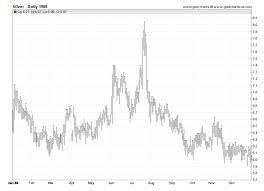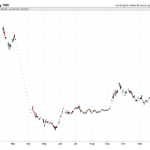The fluctuations of silver prices have been a topic of interest for economists and investors alike, as they are influenced by a multitude of economic factors and geopolitical events. The year of 1988 was no exception, as silver prices experienced significant fluctuations throughout the year, reaching a peak in July and a low point in December.
While some may attribute these fluctuations to specific events or factors, it is important to investigate the truth of these theories to gain a comprehensive understanding of the complex nature of silver prices.
This article will delve into the fluctuations, factors, and geopolitical events that influenced silver prices in 1988. By examining daily silver price data from 1968 to 2021 and LBMA silver price fix history data, we aim to provide a detailed and objective analysis of the factors that contributed to the fluctuations in silver prices.
Through this analysis, we hope to shed light on the intricate relationship between economic factors and geopolitical events, and their impact on the silver market.
Fluctuations and Trends
The fluctuating and trend-driven nature of silver prices in 1988 highlights the volatility of the silver market. Prices fluctuated throughout the year and were influenced by various economic factors and geopolitical events. These fluctuations had a significant impact on investment strategies and emphasized the importance of a comprehensive understanding of the market and its historical data before making any investment decisions.
Investors who sought to profit from silver prices needed to closely monitor the market and its fluctuations. The price data from 1988 showed that silver prices could reach highs of $7.82 on July 20 and lows of $6.07 on December 29. The fluctuations were influenced by factors such as supply and demand, the weakening US dollar, and geopolitical events. As such, investors needed to consider these factors and their potential impact on the market before making any investment decisions.
The fluctuations in silver prices served as a reminder of the need for caution and thorough research before investing in any volatile market.
Economic and Geopolitical Factors
Economic and geopolitical conditions were influential in determining the value of silver during the year 1988. One of the key factors that affected silver prices was the weakening of the US dollar. As the US dollar lost value, investors turned to silver as a safe haven investment, driving up demand and prices.
Additionally, global supply and demand played a significant role in silver prices. The global economy was in a state of flux in 1988, with various countries experiencing economic instability. This affected the demand for silver, as some countries experienced decreased demand due to economic uncertainty.
In addition to economic factors, geopolitical events also influenced silver prices in 1988. For example, tensions between the US and the Soviet Union were high during this time, with both countries engaging in a nuclear arms race. This led to increased demand for silver, as the metal was used in the production of nuclear weapons.
Additionally, other geopolitical events, such as conflicts in the Middle East, also affected silver prices by causing supply disruptions and increasing demand for safe haven investments. Overall, the value of silver in 1988 was heavily influenced by a complex web of economic and geopolitical factors, highlighting the interconnectedness of global markets.
LBMA Price Fix and Benchmark
Based on a survey of market participants, the LBMA price fix serves as a benchmark for the value of silver, allowing investors to make informed decisions about their investments and potentially evoking a sense of security in their choices. The price fix is conducted daily through an auction process that involves a select group of market participants, including major banks and bullion dealers. The LBMA price fix is widely considered to be an accurate reflection of the value of silver, and its results are used by many investors and businesses around the world.
However, concerns have been raised about the potential for market manipulation in the price fix process. Some critics argue that the small number of market participants involved in the auction could lead to collusion or other forms of manipulation. Additionally, there have been allegations that some participants have used their influence to skew the results in their favor.
Despite these concerns, the LBMA price fix remains a widely accepted benchmark for silver prices, and investors continue to rely on its results to inform their investment decisions.
The impact of industrial demand on silver prices is another factor that contributes to the fluctuations in silver prices. As silver is used in a wide range of industrial applications, including electronics, solar panels, and medical equipment, changes in demand from these industries can have a significant impact on the price of silver. As such, investors and analysts closely monitor trends in industrial demand when assessing the value of silver.
Frequently Asked Questions
How did the price of silver in 1988 compare to previous years?
The price of silver in 1988 was affected by various global events and economic factors, causing fluctuations throughout the year. Comparing to previous years, silver prices were influenced by supply and demand, and had an impact on investment portfolios.
Were there any major silver mining strikes or discoveries that impacted prices in 1988?
Labor disputes in the silver supply chain in 1988 had a minimal impact on silver prices. No major silver mining strikes or discoveries were reported during this period. Other economic and geopolitical factors played a larger role in price fluctuations.
How did the demand for silver in different industries, such as electronics and jewelry, affect prices in 1988?
The demand for silver in the electronics and jewelry industries had a significant impact on prices in 1988. The growing demand for electronics, particularly in developing countries, led to increased demand for silver in the production of electronic components. Additionally, the jewelry industry’s demand for silver also contributed to the fluctuations in prices.
Were there any government policies or regulations that affected the price of silver in 1988?
Did government policies or regulations affect silver prices in 1988? The US government’s sale of silver from the Strategic Stockpile and the COMEX’s silver market manipulation allegations impacted supply and demand dynamics, influencing silver prices.
How did the price of silver in 1988 compare to other precious metals, such as gold and platinum?
In 1988, silver prices were lower than both gold and platinum prices. However, palladium prices were similar to silver prices. Global economic events such as the weakening of the US dollar had an impact on silver prices.





